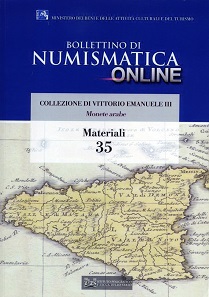by Ursula Kampmann
translated by Katja Protsiva
March 1, 2018 – It is a truism that collecting coins is a royal pastime. An immense number of princes followed their passion for this in the past. Among them was the unfortunate Vittorio Emanuele III who was dethroned for supporting the fascists. He started to collect coins already as a crown prince. Not only did he initiate the writing of the Corpus Nummorum Italicorum, which is still widely used today, he also contributed to it as an author. After his abdication, his collection was forfeited to the state. Today, it is housed in the Gabinetto Numismatico del Museo Nazionale Romano. Now, the collection is being republished under the auspices of the Soprintendenza Speciale per il Colosseo. Arianna D’Ottone dealt with the king’s Islamic coins.
Arianna D’Ottone Rambach, La collezione di Vittorio Emanuele III. Monete arabe. Bollettino di numismatica on-line, Materiali 35, November 2015. 21.1 x 29.5 cm. 149 p., with images in colour. Paperback. ISSN: 0392-971X.
Just to be clear: This book is far more than a simple catalogue in the manner of the Sylloge Nummorum. It starts with an introduction to the topic – and Arianna D’Ottone Rambach stretches the idea of the introduction. She also wants to demonstrate the role that the study of the Islamic coins played in Italy.
Therefore, she started by collecting data on when and where the king bought the coins. She recapitulated the history of research on the topic, while particularly focusing on all Islamic coins in Sicily. Obviously, she also recapitulated the current state of research on the coins of the Aghlabids, the Fatimid Caliphate and the Khazrunids which circulated and/or were minted in Sicily.
The catalogue of the 80 Islamic coins follows the pattern of all the other volumes of the series. Each coin is depicted greatly enlarged on a separate page. This is followed by a numismatic description which also states the diameter. This feature of cataloguing which seems so evident (and maybe even redundant) to us, turns into a more and more important desideratum of research – that moved to the internet over the last couple of years. Platforms like Coinarchives or Sixbid are among the most important sources for researchers, who are interested in covering the entire material. And on these digital platforms, the pictures are just as large as permitted by resolution and bear no proportion anymore to the actual coin. Therefore, it would be very important for research, that auction houses start stating the diameter of coins as well.
But back to Arianna D’Ottone Rambach’s book: There is a detailed bibliography about every coin, as well as a comment containing the translation of the inscription.
Arianna D’Ottone Rambach’s opus belongs to a work of now 42 volumes, dedicated to the royal collection, largely unnoticed by the numismatic public outside Italy. All volumes are available online. They summerize – of course in Italian – the newest findings of a precisely defined area and present the pieces of that area which are part of the royal collection. The volumes can be read online. It is also possible to download them as files to read and print or bind them for the library.
Whit this, all enthusiasts of Italian numismatics have a free and nearly inexhaustible source. Even though, old-fashioned people like me might find it a pity that the books are not additionally published as printed versions. But that is up to each one individually after all. For example, a German print on demand provider would charge 12.10 Euros (plus postage) for printing a booklet of the series for your private library.
On this website you can find all Bollettini di Numismatica online.
Here you can find Arianna D’Ottone Rambach’s book. On this website you can browse the book or open and even download a PDF file.
And if you want to learn more about the Vittorio Emanuele collection, we can recommend you – surprise, surprise – an article in CoinsWeekly. When the article was published, I still did not know where the collection is housed 😉





